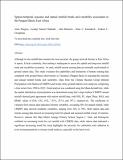| dc.description.abstract | Although in situ rainfall data remains the most accurate, the gauge network density in East Africa is sparse. It lacks continuity, thus making it inadequate to assess the spatial and long-term rainfall trend and variability accurately. As such, rainfall remote sensing data are normally used instead of ground station data. This study evaluates the capabilities and limitations of remote sensing data compared with ground-based observations in Tanzania's Pangani Basin in assessing the seasonal and annual rainfall trends and variability. Data from the Climate Hazards Group Infrared Precipitation with Stations (CHIRPS) and twenty-three ground stations were analyzed, comprising a time series from 1990 to 2022. Trend analysis was conducted using the Mann-Kendall test, while the spatial distribution of precipitation was determined using Sen's slope method. CHIRPS annual rainfall showed good agreement with station rainfall data, with NSE, R2, slope, Pbias, MAE, and RMSE values of 0.84, 0.92, 0.92, 7.55%, 297.4, and 397.1, respectively. The coefficient of variation from station data indicated extreme variability, exceeding 30% for annual rainfall, while CHIRPS data showed moderate variability, ranging from 20% to 30%. Both station data and remote sensing data showed an increasing trend for annual and seasonal rainfall at least 10 stations. However, stations like Maji Moshi, Kiungu Primary School, Segera C. Tank, and Kibong'oto exhibited an increasing trend for vuli rainfall with CHIRPS data, while station data indicated a significant decreasing trend.The study highlights the necessity for calibration and validation to avert misinterpretations in climate trend analyses, especially at the basin level. | en_US |

